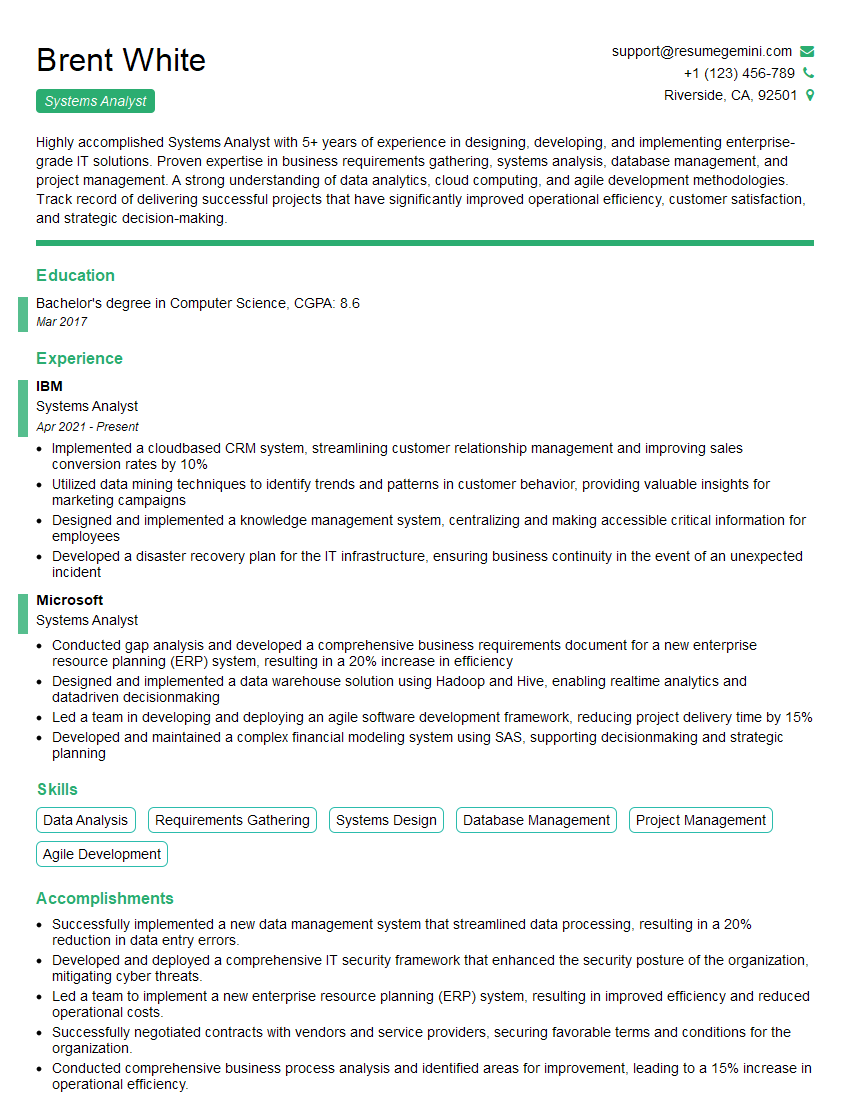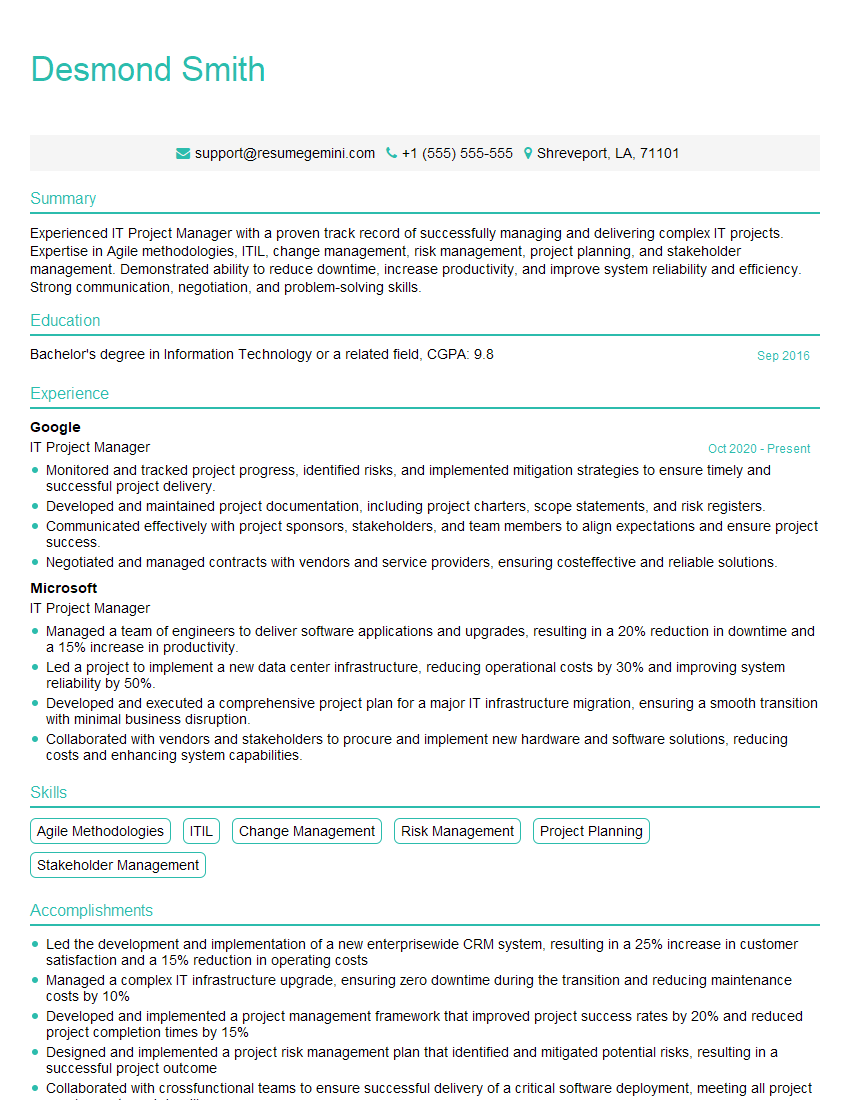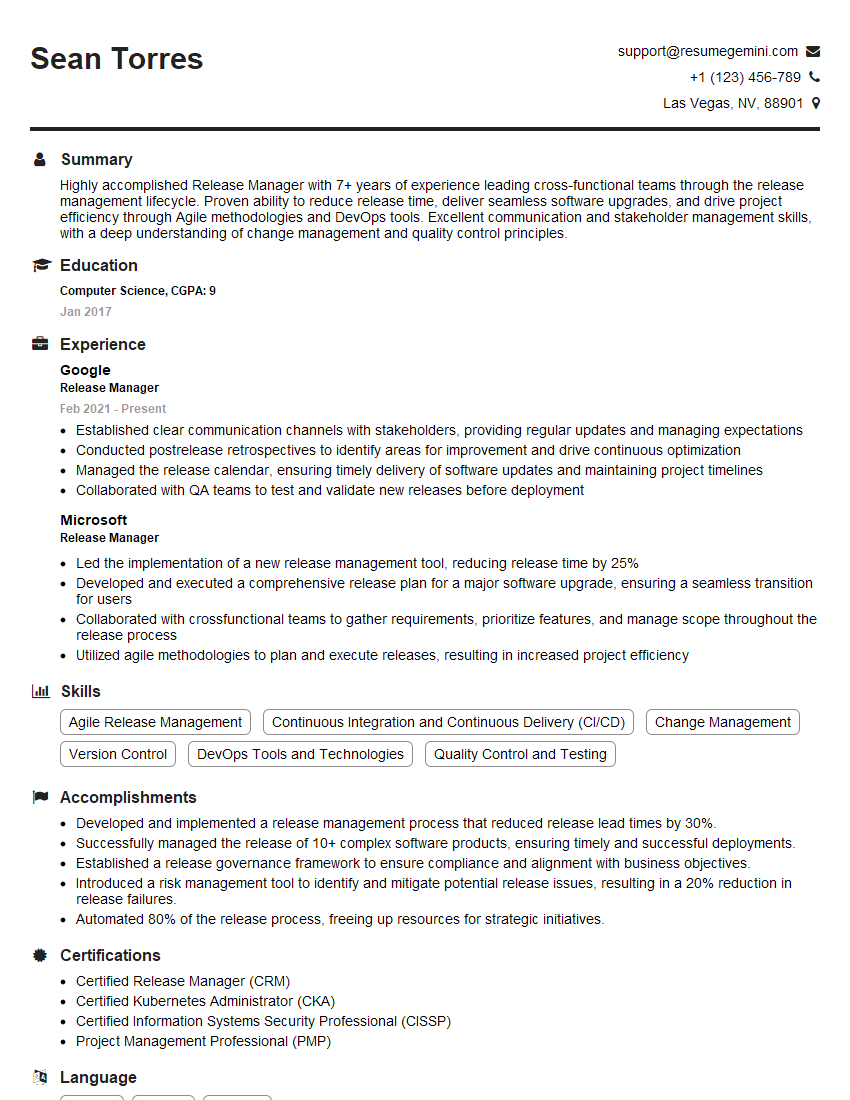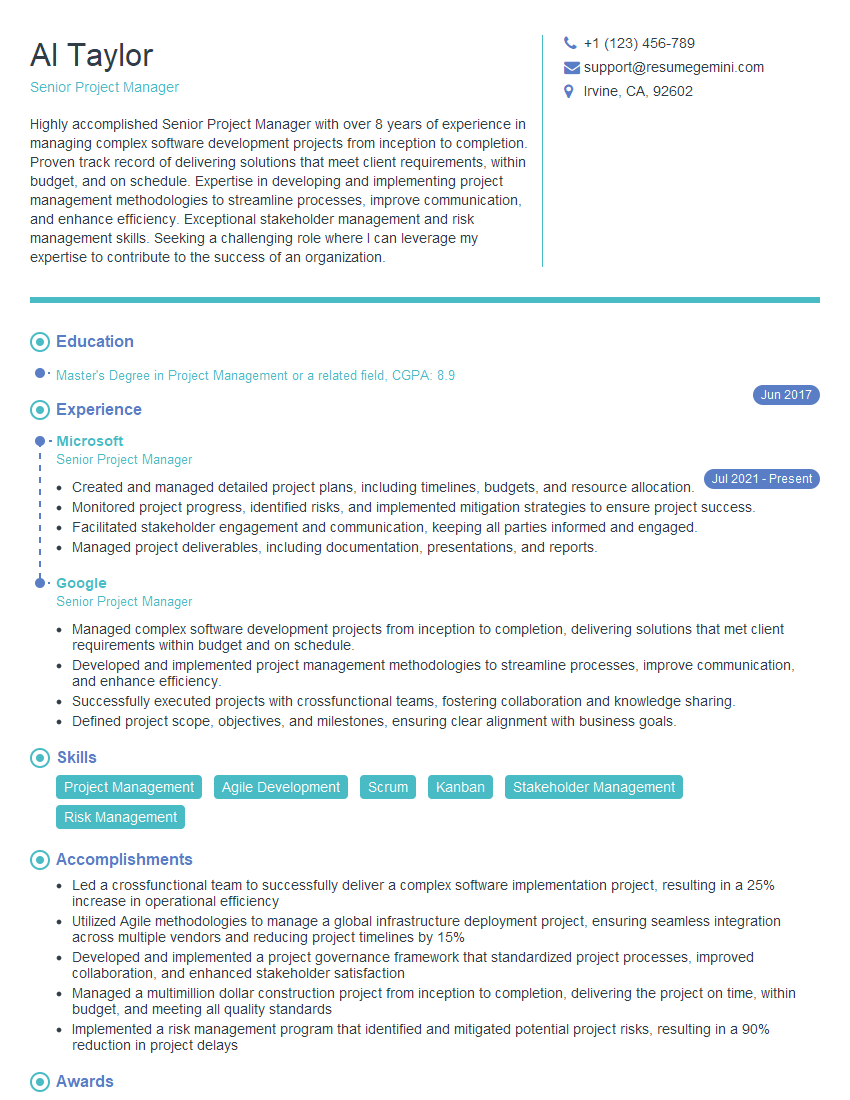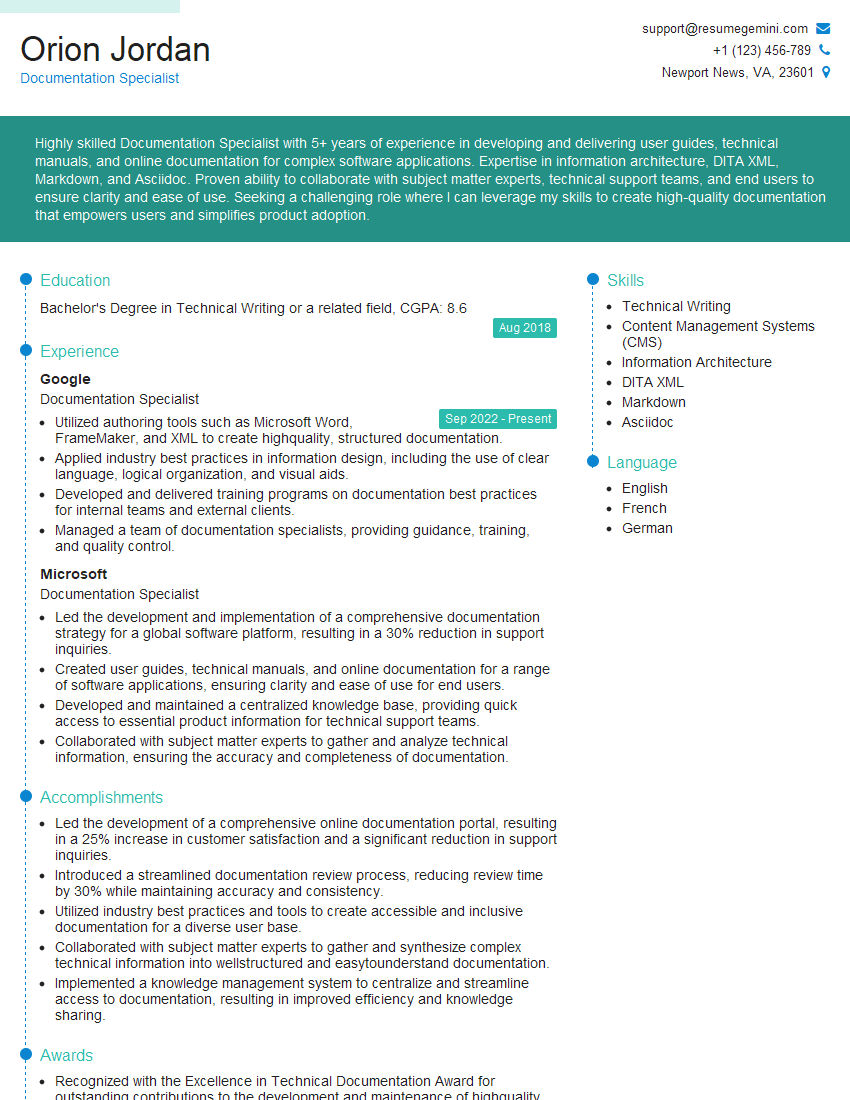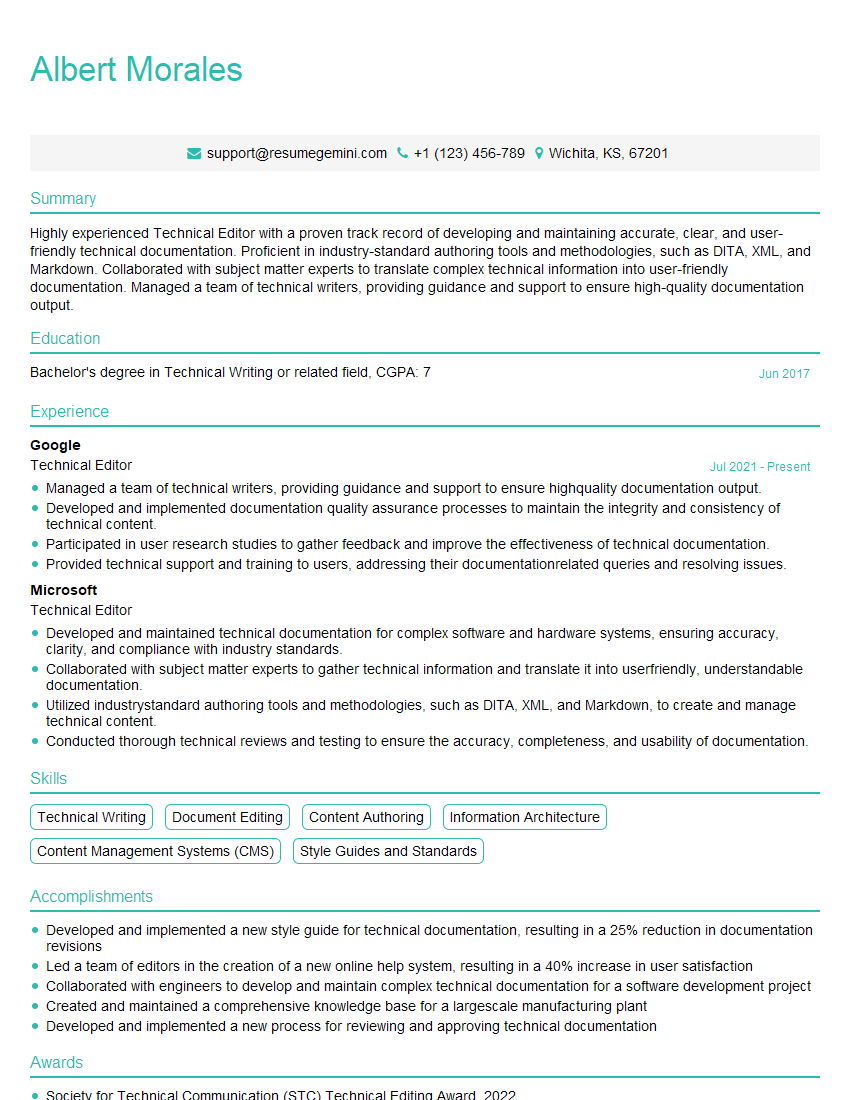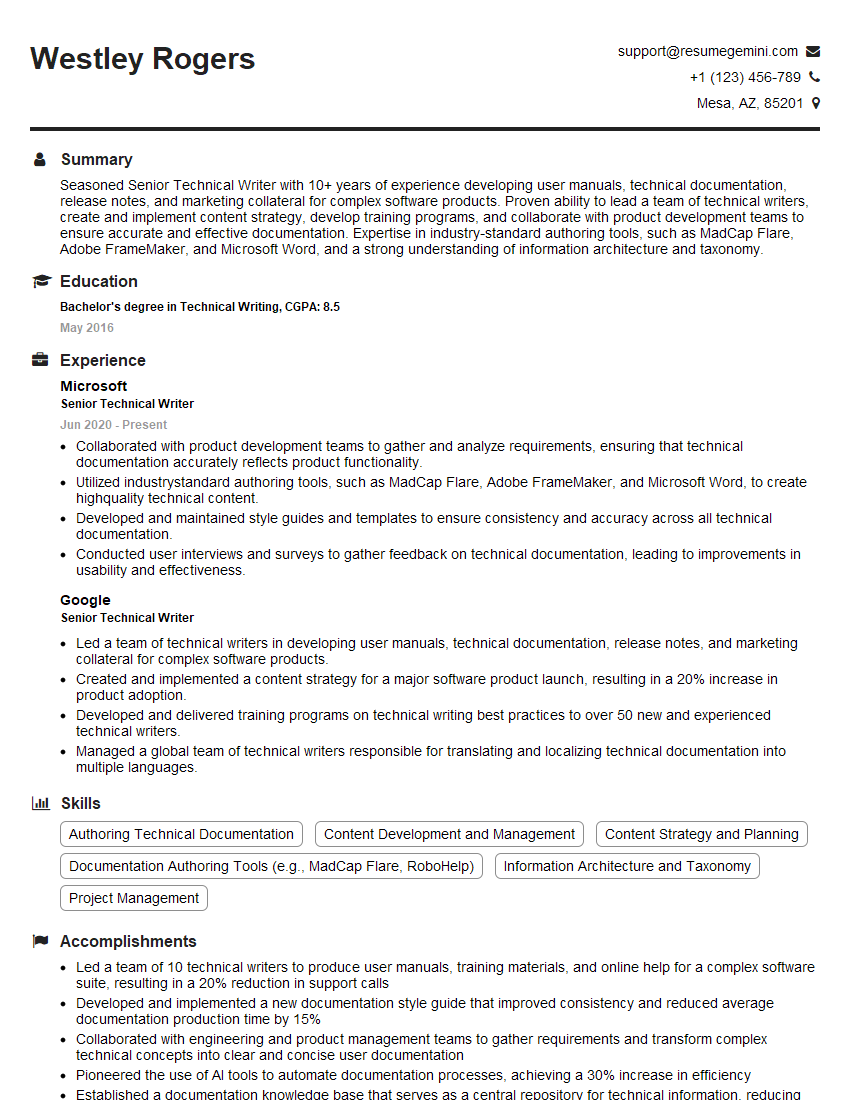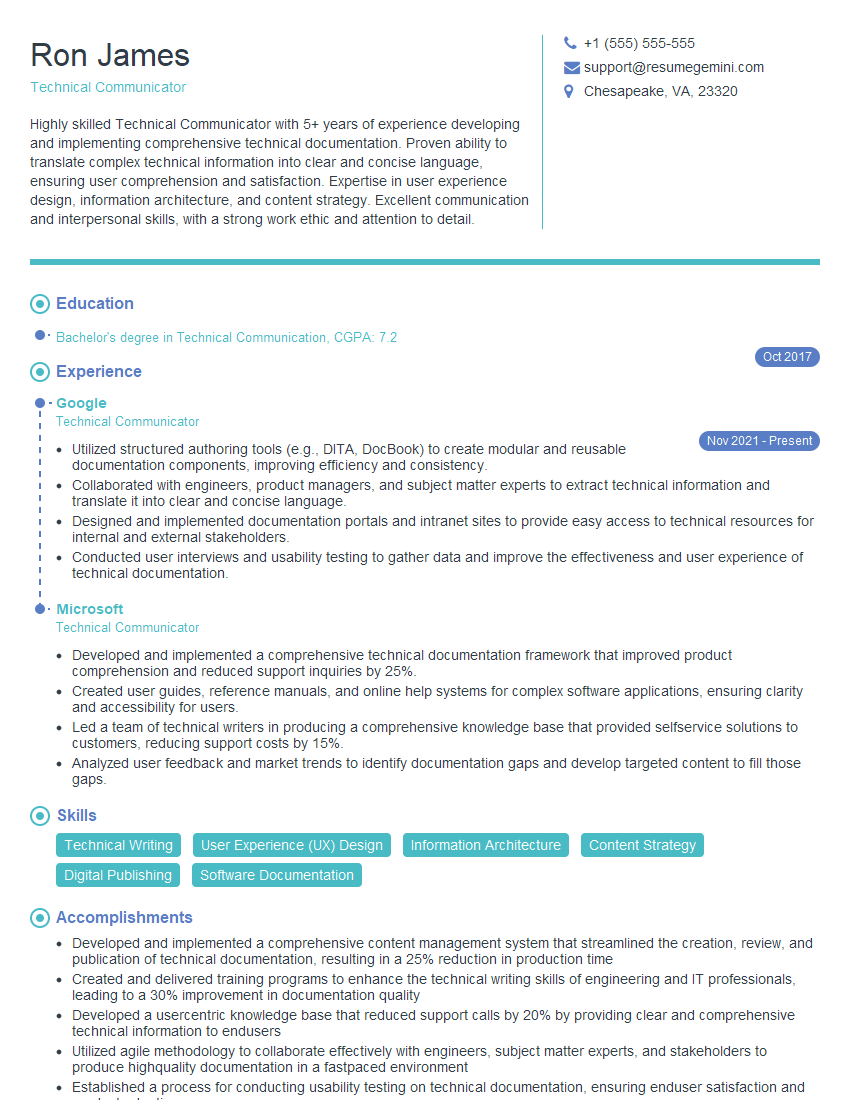Preparation is the key to success in any interview. In this post, we’ll explore crucial Project Management and Technical Documentation interview questions and equip you with strategies to craft impactful answers. Whether you’re a beginner or a pro, these tips will elevate your preparation.
Questions Asked in Project Management and Technical Documentation Interview
Q 1. Describe your experience with Agile methodologies (e.g., Scrum, Kanban).
Agile methodologies, such as Scrum and Kanban, are iterative approaches to project management that emphasize flexibility, collaboration, and rapid delivery. My experience spans several years working in both Scrum and Kanban environments. In Scrum, I’ve participated in daily stand-ups, sprint planning, sprint reviews, and retrospectives. I’m proficient in using Scrum boards to track progress and manage tasks. I understand the importance of well-defined user stories and acceptance criteria. In Kanban, I’ve worked with Kanban boards to visualize workflow, limit work in progress (WIP), and identify bottlenecks. I’ve successfully implemented Kanban systems in several projects, leading to improved workflow efficiency and reduced lead times. For example, in a recent project developing a new software application, we used Scrum. The iterative approach allowed us to quickly adapt to changing requirements and deliver a functional product incrementally. We held regular retrospectives to identify areas for improvement in our processes. In another project focused on website maintenance, we adopted Kanban to manage ongoing tasks and prioritize urgent issues efficiently.
Q 2. Explain your process for creating a project plan.
Creating a robust project plan involves several key steps. First, I define the project scope, objectives, and deliverables clearly. This involves collaboration with stakeholders to ensure everyone is on the same page. Next, I break down the project into smaller, manageable tasks, creating a Work Breakdown Structure (WBS). Then, I estimate the time and resources required for each task, considering potential risks and dependencies. This often involves utilizing techniques like three-point estimating (optimistic, most likely, pessimistic). I then sequence the tasks, creating a schedule using tools like Gantt charts or project management software. Finally, I establish a baseline plan, which serves as a benchmark for tracking progress and making adjustments as needed. For example, in a recent website redesign project, I created a WBS breaking down the project into phases like planning, design, development, testing, and deployment. Each phase had its own set of tasks with associated timelines and resource allocations. I used Microsoft Project to create a Gantt chart visualizing the project schedule and dependencies. This allowed me to easily identify potential critical paths and proactively manage resource allocation.
Q 3. How do you handle conflicting priorities in a project?
Conflicting priorities are a common challenge in project management. My approach involves a structured process to resolve them effectively. First, I prioritize based on business value and urgency using techniques like the MoSCoW method (Must have, Should have, Could have, Won’t have). This often involves discussions with stakeholders to understand the relative importance of different tasks. Next, I clearly communicate the prioritization decisions to the team to ensure transparency and avoid confusion. If needed, I may re-scope the project to focus on the most critical tasks. Negotiation and compromise are crucial in these situations, balancing competing needs. In one instance, we had conflicting priorities between developing new features and fixing bugs. By using a weighted scoring system that considered business impact and user urgency, we were able to prioritize the most critical tasks and deliver a stable and valuable product.
Q 4. What tools and techniques do you use for risk management?
Risk management is a crucial aspect of project success. My process starts with identifying potential risks using techniques like brainstorming, SWOT analysis, and reviewing historical data. Then, I analyze the likelihood and impact of each risk, prioritizing those with high probability and significant consequences. For mitigation, I develop contingency plans to address identified risks, such as allocating buffer time in the schedule or having backup resources available. I also use tools like risk registers to track identified risks, their mitigation strategies, and their status. Regular risk reviews are conducted throughout the project lifecycle to assess the effectiveness of the mitigation strategies and identify any emerging risks. For instance, in a project involving external vendors, we identified the risk of delays due to vendor performance issues. We mitigated this risk by building in buffer time into the schedule and by closely monitoring the vendor’s progress.
Q 5. Describe your experience with different documentation formats (e.g., PDF, HTML, Wiki).
My experience encompasses a wide range of documentation formats, including PDF, HTML, and Wiki. PDFs are ideal for static documents requiring a consistent format, such as reports or manuals. HTML offers more dynamic capabilities, enabling interactive elements and easier online access, which is perfect for online help systems or web-based documentation. Wikis provide collaborative editing features, facilitating team contributions and version control; this is great for living documents that require frequent updates. I’m proficient in using various tools to create and manage these formats, such as Adobe Acrobat for PDFs, various HTML editors, and platforms like Confluence or MediaWiki for wikis. I choose the format that best suits the needs of the audience and the nature of the information being conveyed.
Q 6. How do you ensure the accuracy and consistency of your technical documentation?
Ensuring accuracy and consistency in technical documentation is paramount. I employ several strategies to achieve this. First, I utilize a style guide and template to maintain a consistent tone, style, and formatting. This includes guidelines on terminology, grammar, and visual elements. Secondly, I use a version control system to track changes and allow for collaboration and review. Tools like Git are invaluable for this purpose. Thirdly, I conduct thorough reviews and testing of the documentation, often involving peer reviews and user feedback, to identify errors and areas for improvement. Finally, I use automated tools for checking grammar, spelling, and style consistency. In a recent project, we used a style guide to ensure consistency in technical terms and formatting. We used a review process involving multiple team members to catch errors and inconsistencies before publishing.
Q 7. What are your preferred methods for gathering information for documentation?
Gathering information for documentation involves various methods depending on the context. I often start with reviewing existing materials, such as requirements documents, design specifications, and code. I then conduct interviews with subject matter experts (SMEs) to gather missing information and clarify ambiguities. Observation of processes and workflows can also provide valuable insights. Finally, I leverage user feedback to ensure the documentation aligns with user needs. For example, in documenting a new software feature, I first reviewed the design specifications, then interviewed the developers to understand the technical details, and finally, I conducted user testing to gather feedback on the clarity and usability of the documentation.
Q 8. Explain your experience with version control systems (e.g., Git).
Version control systems, like Git, are fundamental to collaborative documentation and project management. They track changes, allowing for easy rollback to previous versions, collaboration amongst multiple authors, and the management of different document iterations. My experience with Git spans several years, encompassing both individual and team projects. I’m proficient in branching strategies (like Gitflow), merging, resolving conflicts, and utilizing platforms like GitHub and GitLab. For example, in a recent project documenting a complex software API, our team used Git’s branching capabilities to develop and test different sections of the documentation concurrently. This prevented conflicts and allowed for parallel progress.
I regularly use commands such as git clone, git add, git commit, git push, git pull, and git merge to manage the documentation lifecycle. Understanding branching strategies, like feature branches and release branches, is crucial for maintaining a clean and organized repository, ensuring that edits are tracked effectively, and enabling seamless collaboration with other team members. Furthermore, I utilize pull requests and code reviews to ensure the quality and consistency of our documentation.
Q 9. How do you manage feedback from stakeholders on documentation?
Managing stakeholder feedback is crucial for producing effective technical documentation. My approach involves establishing a clear feedback mechanism, typically through a designated platform like a project management tool or a dedicated feedback form. This allows for organized collection and tracking of comments. I then categorize the feedback (e.g., clarity issues, factual errors, omissions) and prioritize them based on impact and urgency. I respond promptly to all feedback, acknowledging the input and indicating the planned actions. For complex or multiple changes, I’ll create a detailed change log to ensure transparency.
I always aim for collaborative dialogue; feedback isn’t just accepted passively but used to initiate further discussion if necessary. For instance, if feedback is unclear, I’ll contact the stakeholder to clarify their concerns. This collaborative approach ensures buy-in and leads to higher quality documentation that genuinely meets the needs of its users.
Q 10. What are your strategies for writing clear and concise technical documentation?
Writing clear and concise technical documentation requires a structured approach. I begin with a thorough understanding of the target audience – their technical expertise and their needs in using the documented system. This informs my writing style and the level of detail included. I use a simple, direct writing style, avoiding jargon whenever possible. Instead of complex sentences, I favor short, declarative sentences that convey information efficiently. I also break down complex topics into smaller, more manageable chunks using headings, subheadings, and lists.
Active voice is preferred over passive voice to improve readability. Visual aids like diagrams, screenshots, and code examples are incorporated judiciously to enhance understanding. Finally, a rigorous review process, including self-review and peer review, helps to identify and correct any ambiguity or inconsistency before publication. I often employ the ‘Tell-Show-Do’ method, first explaining the concept, then showing examples, and finally, guiding the user through steps.
Q 11. Describe your experience with single-sourcing and content reuse.
Single-sourcing and content reuse are critical for maintaining consistency and efficiency in technical documentation. Single-sourcing involves storing information in a central repository, eliminating redundant content. This means if a piece of information is updated in one place, it’s automatically updated everywhere it’s used. Content reuse takes this further, promoting the use of pre-written components across multiple documents. This approach significantly reduces time and effort spent on documentation, ensuring consistency across all materials.
In practice, this often involves using a component content management system (CCMS) to manage and reuse content. I’ve utilized such systems in several projects, resulting in a significant decrease in production time and increased consistency. For example, a frequently used glossary definition doesn’t need to be rewritten each time; it’s simply linked or reused across relevant documents. This ensures terminological consistency and reduces the chance of conflicting information.
Q 12. How do you prioritize tasks when working on multiple documentation projects?
Prioritizing tasks across multiple documentation projects requires a strategic approach. I often use a combination of methods. First, I assess the urgency and importance of each task using a matrix (e.g., Eisenhower Matrix, prioritizing by urgency and importance). This helps to identify critical tasks that need immediate attention versus those that can be scheduled later. Second, I consider the dependencies between tasks; some tasks may need to be completed before others can begin. Third, I break down large tasks into smaller, more manageable sub-tasks. This makes them less daunting and allows for more flexible scheduling and progress tracking.
I typically use project management tools like Jira or Asana to track tasks, deadlines, and progress. These tools enable a clear overview of all projects and allow for effective time management. Regular review and adjustment of the priority list based on changing requirements or emergent issues is crucial for staying on track and meeting deadlines.
Q 13. How familiar are you with different types of technical documentation (e.g., user manuals, API specifications)?
I’m familiar with a wide range of technical documentation types. This includes:
- User Manuals: These guide users on how to use a product or system, ranging from simple step-by-step instructions to in-depth tutorials.
- API Specifications: Detailed descriptions of Application Programming Interfaces, including methods, parameters, and return values. Often written in formats like OpenAPI/Swagger.
- System Documentation: Overviews of complex systems, their architecture, and how different components interact.
- Troubleshooting Guides: Help users resolve problems and errors they encounter while using a product or system.
- Release Notes: Summaries of changes, bug fixes, and new features included in a new software version or product update.
- Training Materials: Guides and tutorials designed to teach users how to use a product or system effectively, often incorporating interactive elements.
My experience covers various formats, including online help systems, printed manuals, and video tutorials. The specific approach to documenting each type depends on the target audience and the nature of the product or system.
Q 14. Describe a time you had to adapt your documentation strategy to meet changing project requirements.
In a recent project documenting a new software platform, the initial requirements focused heavily on detailed technical specifications. However, midway through the project, the stakeholders decided to shift the focus to a more user-centric approach, prioritizing ease of use and accessibility for a less technical audience. This required a significant adaptation of our documentation strategy.
We transitioned from a heavily technical writing style to a simpler, more conversational tone. We incorporated more visual aids, such as screenshots and video tutorials, to guide users through the platform’s features. We also reorganized the documentation structure to make it more intuitive and user-friendly. This involved significant rewriting and restructuring of existing content and the addition of new, more user-focused sections. This experience highlighted the importance of flexibility and responsiveness to changing project requirements in technical documentation.
Q 15. How do you ensure your documentation is accessible to a variety of audiences?
Creating accessible technical documentation means tailoring it to diverse audiences with varying technical expertise. I achieve this through a multi-pronged approach.
- Layered Approach: I structure documentation with multiple layers. A high-level overview caters to beginners, while detailed sections address advanced users. Think of it like a Russian nesting doll – you can peel back the layers to find the information you need.
- Targeted Content: I segment the documentation based on user roles. For example, a developer’s guide will differ significantly from an end-user manual. This ensures that each audience receives relevant information without unnecessary complexity.
- Clear and Concise Language: I avoid jargon and technical terms whenever possible. When necessary, I define them clearly, providing plain-language explanations. Imagine explaining a complex concept to your grandmother – that’s my goal.
- Visual Aids: Diagrams, screenshots, and videos significantly improve comprehension for all users. A picture truly is worth a thousand words.
- Multiple Formats: I offer documentation in various formats (PDF, online help, video tutorials) to cater to different preferences and accessibility needs. Some prefer a printed manual, while others prefer interactive online help.
For example, when documenting a software application, I’d create a quick-start guide for new users, a detailed user manual for regular users, and a separate API reference for developers. Each document would be tailored to its target audience’s needs and knowledge level.
Career Expert Tips:
- Ace those interviews! Prepare effectively by reviewing the Top 50 Most Common Interview Questions on ResumeGemini.
- Navigate your job search with confidence! Explore a wide range of Career Tips on ResumeGemini. Learn about common challenges and recommendations to overcome them.
- Craft the perfect resume! Master the Art of Resume Writing with ResumeGemini’s guide. Showcase your unique qualifications and achievements effectively.
- Don’t miss out on holiday savings! Build your dream resume with ResumeGemini’s ATS optimized templates.
Q 16. How do you measure the effectiveness of your technical documentation?
Measuring the effectiveness of technical documentation is crucial. I employ a variety of methods to assess its impact.
- User Feedback Surveys: I gather feedback through surveys and questionnaires, asking users about clarity, completeness, and usefulness. This provides direct insights into user experience.
- Support Ticket Analysis: Analyzing support tickets helps identify areas where documentation is lacking or unclear. A high number of tickets related to a specific feature suggests the documentation for that feature needs improvement.
- Task Completion Time: By tracking how long it takes users to complete specific tasks using the documentation, I can gauge its efficiency. Faster completion times indicate well-written and effective documentation.
- Website Analytics: For online documentation, I track metrics such as page views, time spent on pages, and search terms used to understand user behavior and identify areas that require attention.
- User Interviews: Conducting user interviews provides qualitative data and deeper understanding of user experiences and challenges. This allows for more nuanced improvement strategies.
For instance, if support tickets consistently address the same topic despite clear documentation, it highlights a need for revision or supplementary materials.
Q 17. What are your skills in using documentation authoring tools (e.g., MadCap Flare, RoboHelp)?
I’m proficient in several documentation authoring tools, including MadCap Flare and RoboHelp. My experience encompasses utilizing their full feature sets for creating and managing complex technical documentation projects.
- MadCap Flare: I’m skilled in using Flare’s single-sourcing capabilities, content reuse features, and its powerful output options (HTML5, PDF, EPUB) to create consistent and easily maintainable documentation. I’ve leveraged Flare’s powerful search functionality, conditional text, and responsive design capabilities to create user-friendly documentation.
- RoboHelp: My RoboHelp expertise includes creating responsive help systems, leveraging its content management capabilities, and using its built-in features for creating various output formats, including web-based help, PDF, and CHM files. I’ve successfully managed large documentation projects within RoboHelp’s framework.
In practice, I choose the tool best suited for the project’s specific needs and client requirements. Both tools offer robust functionalities but have their own strengths. For instance, Flare excels in single-sourcing and responsive design, while RoboHelp might be preferred for its ease of use in specific contexts.
Q 18. What is your experience with creating diagrams and illustrations for technical documentation?
Creating clear and effective diagrams and illustrations is integral to my documentation process. I utilize various tools and techniques to ensure visuals enhance understanding.
- Software Proficiency: I’m experienced in using tools such as Adobe Illustrator, Visio, and Lucidchart to create professional-looking diagrams, flowcharts, wireframes, and other visual aids. These tools allow me to create high-quality graphics that effectively communicate complex information.
- Style Consistency: I maintain a consistent visual style across all diagrams and illustrations to ensure uniformity and professional appearance. I often use style guides to ensure branding consistency.
- Accessibility: I ensure that all diagrams and illustrations are accessible to users with disabilities, using appropriate alt text and ensuring sufficient color contrast.
- Collaboration: I collaborate closely with subject matter experts (SMEs) and designers to ensure that the visuals accurately represent the technical information and meet the overall aesthetic goals of the documentation.
For instance, when documenting a network configuration, I would create a clear network diagram using Visio, illustrating the different components and their interconnections. This visual representation significantly improves understanding compared to a purely textual description.
Q 19. How do you handle technical issues or ambiguities when creating documentation?
Handling technical ambiguities and issues is a key aspect of technical documentation. My approach involves a systematic process to ensure accuracy and clarity.
- Subject Matter Expert (SME) Consultation: I consult with SMEs to clarify any technical ambiguities or resolve conflicting information. This ensures the accuracy of the documentation and eliminates potential misunderstandings.
- Thorough Research: I conduct in-depth research to understand the technical details and resolve any uncertainties. This might involve reviewing source code, testing the application, and reviewing related documentation.
- Version Control: I use version control systems to track changes and resolve conflicts. This ensures a clear history of revisions and helps maintain the integrity of the documentation.
- Testing and Review: I rigorously test the documentation to identify any errors or inconsistencies. Peer reviews and user testing help identify potential ambiguities or areas that need improvement.
- Clear Issue Tracking: I maintain a detailed log of any technical issues encountered and the steps taken to resolve them. This helps in future iterations and avoids repeating similar mistakes.
For example, if I encounter conflicting information about a specific API function, I would consult with the developer team to clarify the correct usage and update the documentation accordingly.
Q 20. How do you stay up-to-date with changes in technology and documentation best practices?
Staying current in the rapidly evolving fields of technology and documentation best practices requires a proactive approach.
- Industry Publications and Blogs: I regularly read industry publications, blogs, and online resources to stay abreast of new technologies, tools, and documentation trends. This keeps me informed about the latest developments and best practices.
- Conferences and Workshops: Attending industry conferences and workshops allows me to network with peers and learn from experts in the field. This provides valuable insights and opportunities to exchange knowledge.
- Online Courses and Training: I actively participate in online courses and training programs to enhance my skills and knowledge in specific areas. This helps me maintain a high level of competency.
- Professional Organizations: I’m a member of relevant professional organizations that provide access to resources, training, and networking opportunities. This offers a structured approach to continuing professional development.
- Experimentation and Practice: I actively experiment with new technologies and tools, and apply new knowledge and techniques in real-world projects. Hands-on experience solidifies understanding and keeps skills sharp.
For example, I regularly attend conferences focused on technical communication and actively follow prominent figures in the field on social media and through their publications.
Q 21. Explain your experience with the project lifecycle (initiation, planning, execution, monitoring, closure).
My experience with the project lifecycle is extensive, encompassing all phases from initiation to closure. I’m adept at managing projects using various methodologies, including Agile and Waterfall.
- Initiation: In this phase, I define the project scope, objectives, and deliverables. This includes identifying stakeholders, defining success criteria, and obtaining necessary approvals.
- Planning: The planning phase involves creating a detailed project plan, including task assignments, timelines, resource allocation, and risk assessment. This often involves the creation of Gantt charts and work breakdown structures (WBS).
- Execution: During execution, I actively monitor progress, manage resources, and address any issues that arise. Regular status meetings and progress reports are crucial at this stage.
- Monitoring and Controlling: This involves tracking progress against the project plan, identifying potential risks and issues, and implementing corrective actions. I regularly use project management tools to track progress and manage resources effectively.
- Closure: This involves formally completing the project, documenting lessons learned, and conducting a post-project review. This phase is crucial for continuous improvement and for sharing knowledge.
For instance, in a recent project involving the creation of a comprehensive technical manual for a new software product, I followed a phased approach, starting with defining the scope and target audience, creating a detailed project schedule, assigning tasks to team members, regularly monitoring progress via project management tools and finally conducting a post-project review to capture lessons learned and improve future documentation projects.
Q 22. How do you use project management software (e.g., Jira, Asana, MS Project)?
Project management software is integral to my workflow. I’ve extensively used Jira, Asana, and MS Project, each offering unique strengths depending on the project’s needs. My approach involves leveraging their core functionalities to streamline various stages of project lifecycle.
Jira: Primarily for agile projects, I use Jira for task management, sprint planning (using Kanban or Scrum boards), bug tracking, and issue resolution. I configure workflows, define statuses, and utilize JQL (Jira Query Language) for advanced reporting and filtering. For example, I might create a custom JQL query to identify all tasks assigned to a specific team member that are overdue.
Asana: I find Asana excellent for managing tasks across multiple projects simultaneously, particularly in collaborative environments. Its intuitive interface and robust communication features are great for teams. I use it to create and assign tasks, set deadlines, track progress via progress bars and timelines, and foster team communication through comments and notifications. For instance, I use Asana’s timeline view to visualize dependencies between tasks and anticipate potential roadblocks.
MS Project: For larger, more complex projects requiring detailed scheduling and resource allocation, MS Project is my go-to tool. I use its Gantt charts to visualize project timelines, assign resources, track critical paths, and manage dependencies between tasks. I can easily analyze the impact of changes on the project schedule and identify potential delays early on. A practical example would be using MS Project to forecast resource requirements for a large-scale software implementation.
Regardless of the software, I always focus on clear task definitions, consistent updates, and effective communication within the team to ensure project success.
Q 23. Describe a situation where you had to manage a challenging stakeholder.
In a recent project involving the development of a new mobile application, I encountered a challenging stakeholder – a senior executive with a very strong vision, but limited understanding of the technical aspects. His frequent requests for last-minute changes threatened project timelines and budget.
To manage this, I employed a multi-pronged approach:
Regular Communication and Transparency: I initiated weekly meetings, providing regular updates with clear explanations of technical implications related to his proposed changes. I presented information visually, using charts and graphs to showcase the impact of decisions on timelines and resources.
Collaborative Problem Solving: Instead of simply rejecting changes, I actively sought to understand the underlying reason for his requests. This allowed us to find alternative solutions that met his strategic goals without disrupting the technical plan. For example, we prioritized features based on a weighted scoring system that incorporated both business value and technical feasibility.
Data-Driven Decision Making: I presented data-backed arguments to justify technical decisions, using project metrics and risk assessments to demonstrate the potential consequences of rushed changes. This helped him understand the implications of his requests and make informed decisions.
Documentation and Agreement: I ensured all agreed-upon changes were documented and formally approved, minimizing future misunderstandings and disputes.
Through consistent communication, collaboration, and data-driven justification, I successfully navigated the stakeholder management challenge, delivering the project on time and within budget, with the executive ultimately satisfied with the final product.
Q 24. How do you ensure that your documentation is up-to-date and accurate?
Maintaining up-to-date and accurate documentation is paramount. My approach involves a combination of strategies and tools:
Version Control: I always use a version control system like Git to track changes and revert to previous versions if needed. This allows for easy collaboration and ensures a clear audit trail of all modifications.
Regular Reviews and Updates: I schedule regular reviews of documentation, ideally incorporating feedback from users and other stakeholders. This ensures that the information remains current and relevant.
Automated Build Processes: When possible, I automate the build and deployment of documentation, integrating the process into the development pipeline. This ensures documentation is updated simultaneously with the software or product.
Single Source of Truth: I maintain a single source of truth for all documentation. This eliminates inconsistencies and ensures that everyone is working with the latest version of the information.
Feedback Mechanisms: I incorporate mechanisms for user feedback, such as surveys or feedback forms, to identify areas for improvement and ensure the accuracy and relevance of the documentation.
This multi-layered approach ensures accuracy, minimizes discrepancies and allows for efficient updates, preventing outdated or erroneous information from reaching end-users.
Q 25. How do you handle conflicting information or conflicting requirements from different stakeholders?
Conflicting information and requirements are inevitable in complex projects. My approach is to systematically address these conflicts through a structured process:
Identify and Document the Conflicts: The first step is to clearly identify and document all conflicting information and requirements. This often involves creating a matrix comparing different stakeholder inputs.
Analyze the Root Cause: Understand why the conflict exists. Are there miscommunication issues? Differing interpretations of requirements? Unclear priorities?
Prioritize Requirements: Using techniques like MoSCoW (Must have, Should have, Could have, Won’t have) or a weighted scoring system, I prioritize the conflicting requirements based on business value, technical feasibility, and risk factors.
Facilitate Stakeholder Discussions: Organize a meeting with all relevant stakeholders to discuss the identified conflicts and reach a consensus. This requires strong facilitation skills to guide the discussion and help everyone reach a mutually acceptable solution.
Document the Resolution: Once a resolution is reached, formally document the decision, including the rationale behind it. This avoids future misunderstandings and ensures consistency.
Communicate the Changes: Clearly communicate the agreed-upon resolution to all stakeholders to avoid confusion or further issues.
This approach ensures all parties are aware of the decision-making process and minimizes the impact of conflicting information on the project.
Q 26. What is your experience with creating style guides and maintaining consistency in documentation?
Creating and maintaining style guides is crucial for consistent documentation. My experience includes developing style guides for various projects, encompassing aspects like:
Terminology: Defining and standardizing terminology used throughout the documentation to avoid confusion.
Formatting: Establishing consistent formatting rules for headings, paragraphs, lists, code snippets, etc. This ensures visual consistency and improves readability.
Tone and Style: Defining the overall tone and style of the documentation (e.g., formal, informal, technical, user-friendly). This ensures a consistent voice throughout.
Graphics and Visuals: Establishing guidelines for images, diagrams, and other visuals to maintain visual consistency.
Tools and Technologies: Specifying preferred tools and technologies for creating and maintaining documentation (e.g., Markdown, specific documentation generators).
I typically use a collaborative approach to develop style guides, involving writers, developers, and stakeholders to ensure the guide reflects everyone’s needs and reflects best practices. The style guide then becomes a living document, updated as needed to reflect changes in the project or organization. This ensures that documentation remains consistent and easily navigable for both internal and external users, improving the overall user experience.
Q 27. How do you ensure the accessibility of technical documentation for users with disabilities?
Ensuring accessibility is a vital part of creating effective technical documentation. My approach centers around adhering to accessibility guidelines, primarily WCAG (Web Content Accessibility Guidelines):
Alternative Text for Images: Providing descriptive alternative text for all images ensures that screen readers can convey the image’s content to visually impaired users.
Semantic HTML: Utilizing appropriate HTML tags (e.g.,
<h1>,<p>,<ul>,<li>) to structure the document semantically improves accessibility for screen readers and assistive technologies.Keyboard Navigation: Ensuring all interactive elements are accessible via keyboard navigation allows users who cannot use a mouse to interact with the documentation.
Color Contrast: Maintaining sufficient color contrast between text and background ensures readability for users with visual impairments.
Structured Content: Organizing content logically with clear headings and subheadings improves navigation and comprehension for all users, especially those with cognitive disabilities.
Document Accessibility Testing: Using accessibility testing tools to verify that the documentation meets accessibility standards before release is crucial.
By following these guidelines, I aim to make technical documentation accessible to all users, regardless of their abilities. This promotes inclusivity and ensures that everyone can benefit from the information provided.
Q 28. Describe your experience with creating and managing a documentation content repository.
I have extensive experience creating and managing documentation content repositories. My approach involves selecting appropriate tools and implementing effective organizational strategies:
Selecting the Right Tool: The choice of repository depends on the project’s needs. Options include cloud-based platforms like Confluence or SharePoint, or version control systems like Git paired with a suitable static site generator.
Establishing a Clear Structure: A well-defined folder structure is essential for easy navigation and organization. This often involves categorizing documents by type, product, or version.
Metadata Management: Utilizing metadata (e.g., keywords, tags, authors, dates) allows for efficient searching and filtering of documents. This is especially important for large documentation sets.
Version Control: Utilizing version control (e.g., Git) allows tracking changes, reverting to previous versions if needed, and facilitates collaboration.
Access Control: Implementing access control mechanisms (e.g., permissions) ensures that only authorized individuals can access and modify documentation.
Regular Maintenance: Regular maintenance includes archiving old documents, deleting outdated information, and ensuring that the repository remains up-to-date and organized. This minimizes clutter and maximizes efficiency.
The goal is to create a centralized, easily searchable, and well-organized repository that makes it easy for users to find the information they need, when they need it.
Key Topics to Learn for Project Management and Technical Documentation Interview
- Project Management Fundamentals: Understanding project lifecycles (Agile, Waterfall), risk management strategies, stakeholder management, and project initiation/closure.
- Practical Application (PM): Describe a past project where you successfully navigated challenges, met deadlines, and managed a team or stakeholders. Be ready to discuss your approach to problem-solving within a project context.
- Technical Documentation Principles: Mastering different documentation types (user manuals, technical specifications, API documentation), information architecture, and effective writing styles for a technical audience.
- Practical Application (TD): Showcase your ability to create clear, concise, and user-friendly documentation. Prepare examples of your work, highlighting your attention to detail and user experience considerations.
- Tools & Technologies: Familiarity with project management software (e.g., Jira, Asana, Trello) and documentation tools (e.g., MadCap Flare, Adobe RoboHelp) will significantly enhance your profile.
- Problem-Solving & Critical Thinking: Be prepared to discuss scenarios requiring critical thinking and problem-solving within both project management and technical documentation contexts. Highlight your analytical skills and ability to make informed decisions.
- Collaboration & Communication: Effective communication and collaboration are crucial. Be ready to discuss instances where you successfully collaborated with diverse teams and stakeholders to achieve common goals.
Next Steps
Mastering Project Management and Technical Documentation opens doors to exciting and rewarding career opportunities, offering growth potential and high demand across various industries. An ATS-friendly resume is crucial for getting your application noticed by recruiters. It’s your first impression – make it count!
To build a truly impactful resume that highlights your skills and experience effectively, leverage the power of ResumeGemini. ResumeGemini provides a trusted platform to craft a professional and compelling resume, increasing your chances of landing your dream job. Examples of resumes tailored to Project Management and Technical Documentation roles are available within ResumeGemini to guide you.
Explore more articles
Users Rating of Our Blogs
Share Your Experience
We value your feedback! Please rate our content and share your thoughts (optional).
What Readers Say About Our Blog
Hello,
We found issues with your domain’s email setup that may be sending your messages to spam or blocking them completely. InboxShield Mini shows you how to fix it in minutes — no tech skills required.
Scan your domain now for details: https://inboxshield-mini.com/
— Adam @ InboxShield Mini
Reply STOP to unsubscribe
Hi, are you owner of interviewgemini.com? What if I told you I could help you find extra time in your schedule, reconnect with leads you didn’t even realize you missed, and bring in more “I want to work with you” conversations, without increasing your ad spend or hiring a full-time employee?
All with a flexible, budget-friendly service that could easily pay for itself. Sounds good?
Would it be nice to jump on a quick 10-minute call so I can show you exactly how we make this work?
Best,
Hapei
Marketing Director
Hey, I know you’re the owner of interviewgemini.com. I’ll be quick.
Fundraising for your business is tough and time-consuming. We make it easier by guaranteeing two private investor meetings each month, for six months. No demos, no pitch events – just direct introductions to active investors matched to your startup.
If youR17;re raising, this could help you build real momentum. Want me to send more info?
Hi, I represent an SEO company that specialises in getting you AI citations and higher rankings on Google. I’d like to offer you a 100% free SEO audit for your website. Would you be interested?
Hi, I represent an SEO company that specialises in getting you AI citations and higher rankings on Google. I’d like to offer you a 100% free SEO audit for your website. Would you be interested?
good





